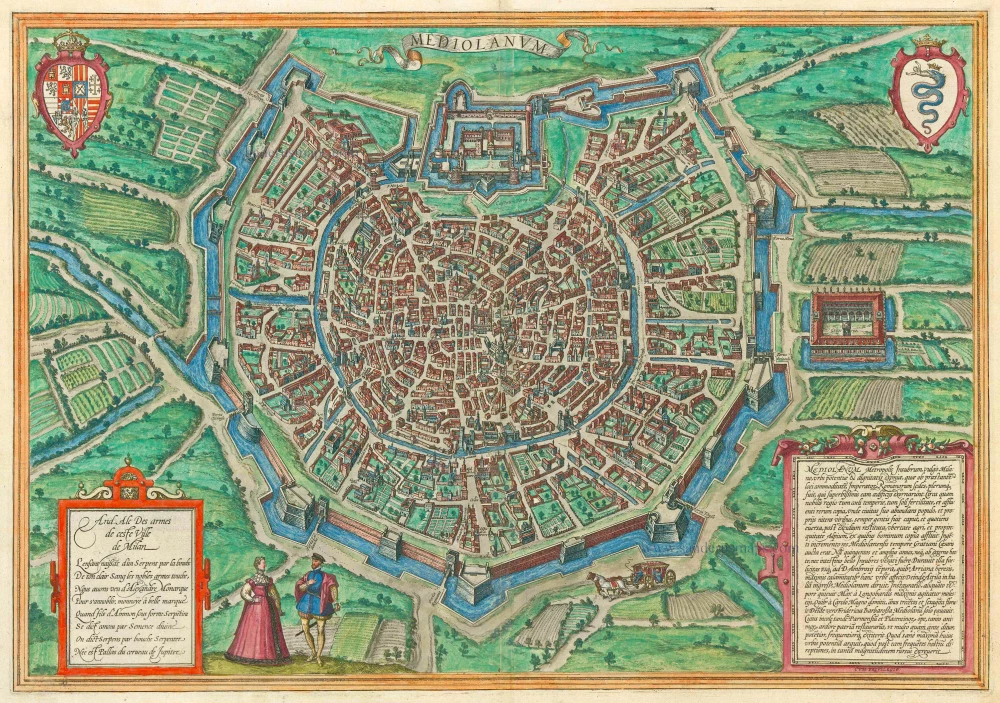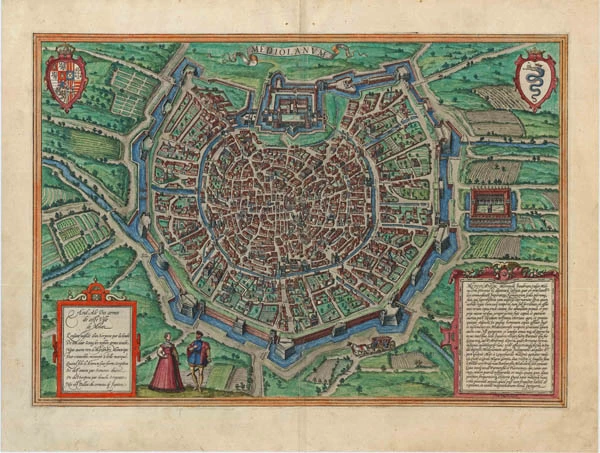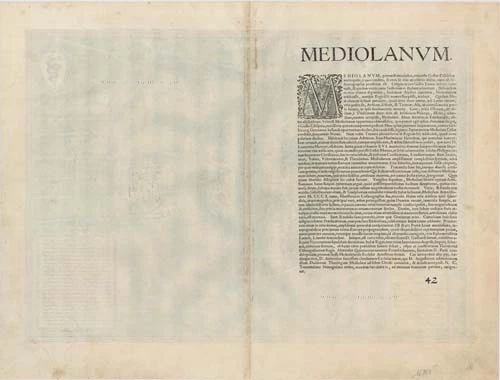Antique map - bird's-eye view plan of Milan (Milano) by Braun & Hogenberg 1575
Mediolanum Metropolis Insubrum, vulgo Milano, ...
Item Number: 16261 Authenticity Guarantee
Category: Antique maps > Europe > Italy
Antique map - bird's-eye view plan of Milan (Milano). by Braun & Hogenberg
CARTOUCHE LEFT: Commentary on the city's coat of arms top right by the humanist and emblematician Andrea Alciato.
TRANSLATION CARTOUCHE RIGHT: Mediolanum, capital of the Insubrians, commonly known as Milan, an extremely powerful and dignified city, which due to its favourable location was generally the seat of the Roman emperors, who embellished it with superb buildings. The region around Milan has a temperate climate, the soils are fertile and everything is present in abundance. [...] The fecund fields and the proximity to the Alps meant that many people flocked from the latter to Milan. Due to a large influx at the time of Emperor Gratian, Milan grew bigger. For over 500 years the Insubrians were namely troubled neither by external enemies nor by internal fighting. This good fortune lasted until the time of St Ambrose, when the Arian heresy inflicted great harm upon the city. Then Attila, who had invaded Italy, destroyed Milan. For a long time after its reconstruction, it had peace. Then it was visited by the Lombards. After their subjugation by Charlemagne, it flourished for 360 years. But then Frederick Barbarossa razed Milan to the ground. With the help of Parma and Piacenza, its inhabitants rebuilt their city with such zeal, such ardour, that it arose even more prosperous, powerful and populated than before [...].
COMMENTARY BY BRAUN: "Milan can be numbered amongst the largest cities in Europe. Running through its suburbs are canals, along which all the necessities of life can be brought into the city by boat. So many different artisans live here that it is said that there are enough to rebuild Italy, but first you would have to destroy Milan in order to persuade its carftsmen and artists to migrate across the rest of Italy. The city has many magnificent houses, each more beautiful than the next, including its main church, with which few order churches in the whole world bear comparison in terms of size and marble décor."
The plan view conveys an impressive picture of the city's distinctively regular layout. The medieval fortifications were replaced in the 16th/17th centuries by the bastion-like city wall, particularly easy to recognize in this bird's-eye perspective. It starts from the Castello Sforzesco (top centre), the former fortified palace of the Sforza Dukes of Milan. In the very centre of the city lies the cathedral of Santa Maria Nascente, commenced in the 14th century and consecrated in 1572. The Gothic city core is located around the cathedral of Santa Maria Nascente, commenced in the 14th century and consecrated in 1572. The Gothic city core is located around the cathedral square. Also visible in this engraving are Milan's oldest churches, all founded in the 4th century: San Lorenzo Maggiore (centre left), Sant'Ambrogio (top left) and Sant'Eustorgio. Leonardo da Vinci's famous Last Supper (1495/97) is housed in Santa Maria delle Grazie (left of the Castello). When Francesco Sforza died without heirs in 1535, Milan passed to Emperor Charles V, who in 1555 bequeathed it in turn to his son Philip II of Spain. Milan remained in Spanish possession until the 18th century. The city is today the financial, fashion and media capital of Italy with 1.3 million inhabitants. (Taschen)
Date of the first edition: 1572
Date of this map: 1575
Copper engraving
Size: 33.5 x 48.5cm (13.1 x 18.9 inches)
Verso text: Latin
Condition: Superb old colour, excellent.
Condition Rating: A+
References: Van der Krogt 4, 2758, State 2; Taschen, Braun and Hogenberg, p.106.
From: Civitates Orbis Terrarum, Liber Primus. Antwerp, Gilles van den Rade, 1575. (Van der Krogt 4, 41:1.1)






